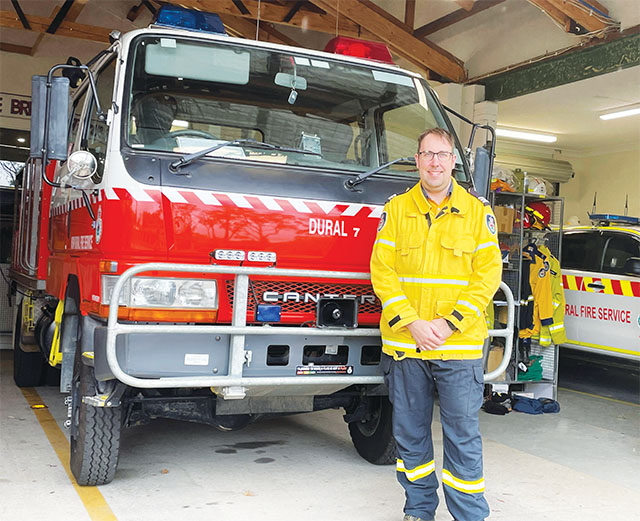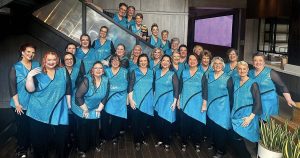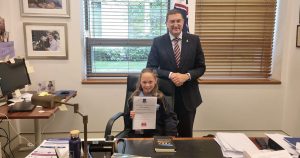[vc_row][vc_column width=”1/6″ offset=”vc_col-lg-1/5 vc_col-md-1/5 vc_col-xs-1/5″][us_image image=”81787″ size=”thumbnail” align=”left” style=”circle” has_ratio=”1″][/vc_column][vc_column width=”1/12″ offset=”vc_col-lg-4/5 vc_col-md-4/5 vc_col-xs-4/5″][vc_column_text]By Virag Toth[/vc_column_text][us_post_date][/vc_column][/vc_row][vc_row][vc_column][vc_column_text]Captain Jarryd Barton has been a firefighter for most of his life. A former Northholm Grammar School student, he joined the Dural Rural Fire Service (RFS) at the age of 16, as part of The Duke of Edinburgh’s Award.
“When I needed to do the community service component for the program, I joined the fire brigade back in 2001. I just never ended up leaving,” he said.
Made up entirely of volunteers, Captain Barton explained to the Galston, Glenorie & Hills Rural Community News that the service has a variety of people from different occupations and backgrounds, all of whom bring their own skillset to protecting the local communities.
“I’m a town planner, as my day job. I work with engineering firms doing town planning, but then other guys in the brigade come from all different types of backgrounds. We have people in emergency services like the police, plumbers, electricians, project managers, mechanics. Everyone comes from somewhere different,” he said.
On September 1st this year, the National Council for Fire and Emergency Services overhauled its fire danger rating standards, establishing a nationwide system with four categories (it used to be six). Captain Barton emphasised the importance of having this consistency, revealing it is crucial to accurate messaging and community safety.
“Everybody will have a better idea of what to do and also have a better awareness of what is happening around them. I guess for our brigade, being in the middle of the state, we didn’t necessarily have any issues with conflicting messaging, but it will be really good for those down near the borders.”
“The new system also provides a lot more detail around the background of why a particular message is being sent out, and there is a lot more science behind the current ratings as well. Having a simpler system that the community can understand easier is great,” he said.
Reflecting on the disastrous 2019-2020 bushfire season that swept across the east coast of Australia, Captain Barton described it as “stressful” and “full-on”.
“That was a really busy time. We were involved in that season from early November, late October in 2019 all the way through to late February, early March the following year. Our brigade went all over NSW, to regional areas and the north and south coast. A couple of guys even went up to Queensland at one stage,” he recalled.
“I think we had about 55 days’ worth of time and over 1,000 manhours of people and trucks out in the field. At that point, I had only been captain for about six months as well.” Captain Barton also spoke about the strategies Dural RFS has implemented to lessen the potential for bushfires to occur, particularly at the start of every season.
“When the weather is appropriate, we do hazard reduction burns as a pre-emptive tactic. Back-burning is more of a defensive strategy, so we use that when there is an actual fire happening. We have our own plan, and every brigade across the area also has one that provides strategic benefit for their district,” he said.
Captain Barton also commented on the recently announced partial merging of the RFS and State Emergency Service (SES), after an inquiry into the Lismore floods, that saw a need for more organised management of emergency response services.
“Any sort of coordination between the two is useful. We do work with the SES with flood recovery, storm damage, and roof repair. Over the last couple of years, we’ve been all over the area working together with them. Most recently we were out at Wiseman’s Ferry and Camden, helping with the flooding there,” he said.
This comradery between emergency response services is also present between fire brigades, particularly in neighbouring suburbs, as Captain Barton revealed.
“The RFS as a whole works as a team. We train together sometimes, especially with Galston and Cherrybrook, and we are looking to do more of that in the future. It’s all just one big service where we get in, work together and get the job done,” he said.
Speaking on the importance of the community being prepared for bushfires, Captain Barton highlighted the need for residents, particularly those in fire-prone areas, to have a bushfire survival plan.
“The best thing is to have a plan or at least have thought about it. You can also download them off the Internet, to have a look at and have an idea of what you need to be thinking about. It’s also key to have situational awareness. You can keep up to date with information with apps like Fires Near Me.”
“Another thing is as simple as deciding whether you are going to stay or leave, if you feel comfortable defending your property, or if you feel safer leaving early. Either one you choose you have to make decisions by staying aware of what is going on around you. The biggest mistake people make is not having a plan,” he said.









